Highlights of the Amsterdam Pipe Museum
Auteur:
Don Duco
Original Title:
Hoogtepunten uit het Amsterdam Pipe Museum
Année de publication:
2020
Éditeur:
Amsterdam Pipe Museum (Stichting Pijpenkabinet)
A clay pipe translated in ivory
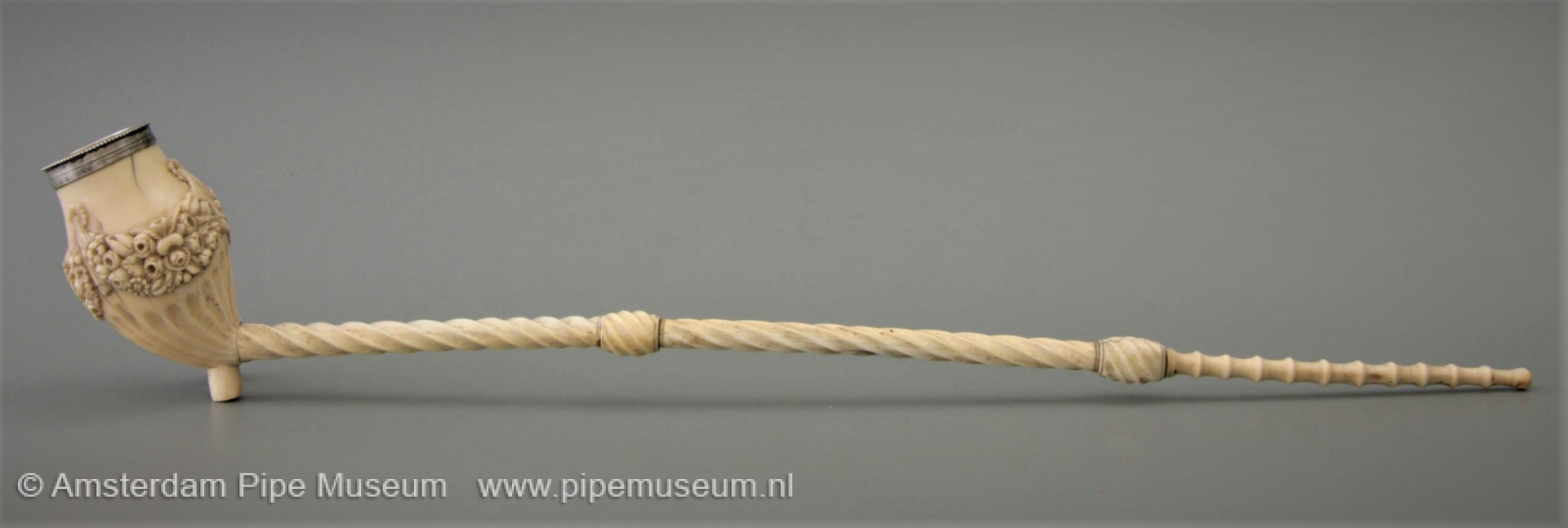
The Gouda pipe of white pipe clay has been a source of inspiration for pipe makers for centuries. The bright white colour, the outbalanced bowl shape and the extremely slender stem were admired worldwide. Unfortunately, hardly any materials can be found that makes it possible to imitate the appearance of the clay pipe. The pipe shown here deserves a price in that respect. The pipe was made by an ivory worker from Dieppe after the example of a clay pipe.
This tobacco pipe has a bowl that is inspired by the oval shape, although it is somewhat thicker and more conical. At the base the well-known heel is applied as marking to the stem transition. Thanks to the heel, the smoker could easily hang the pipe in a pipe rack. The lower part of the bowl is adorned with a band of fluted grooves, while around the belly embossed flower and leaf garlands in Louis XVI style are cut out. These tendrils seem attached to three nails. On the front of the bowl we see a heart-shaped shield, originally intended for the monogram of the smoker or the generous donor. However, this never happened. The silver ring around the bowl opening is subtly decorated with a slightly protruding pearl fillet. That ring was used to reinforce the pipe because ivory is at great risk of cracking.
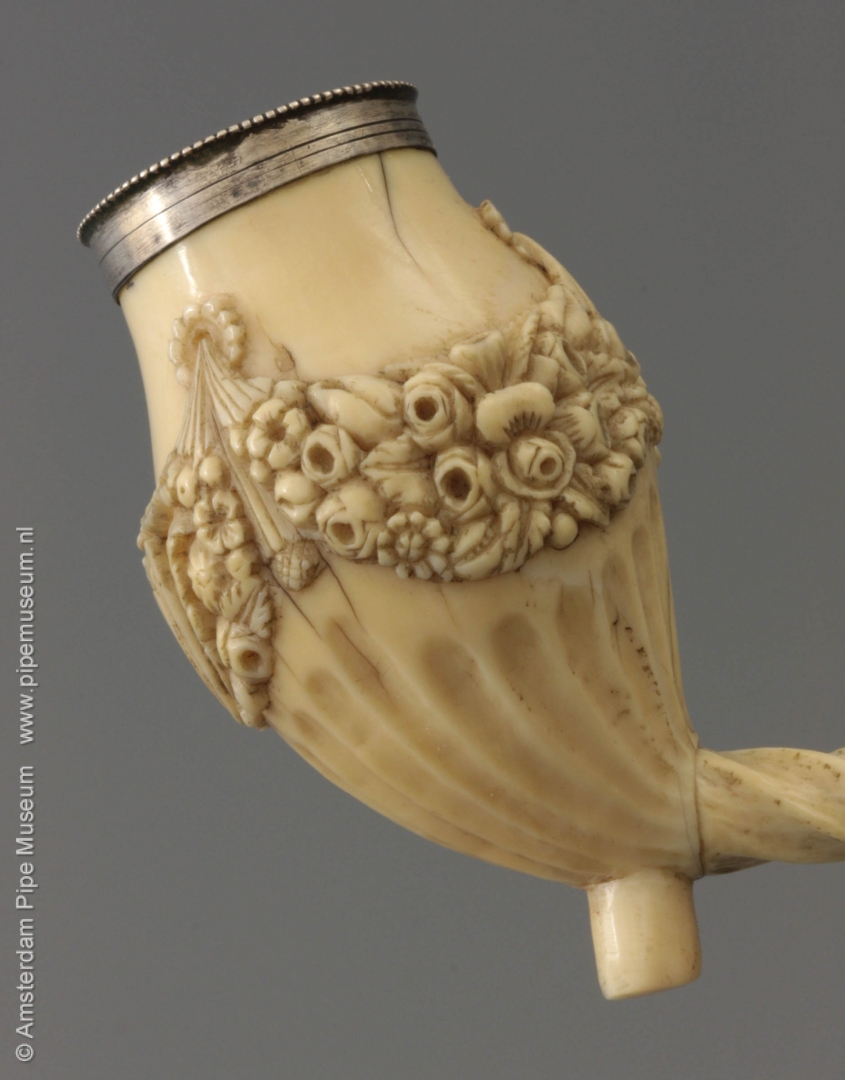

Noteworthy is the twisted stem of the pipe, showing a fine regular torsion that fits perfectly with the fluting around the bowl base. The two buttons as spacers conceal a threaded tab that makes it possible to disassemble the pipe in three pieces. This work is characteristic of ivory turners who had no trouble building objects from different parts and attaching them tightly with screwing tabs. The stem end of the pipe is formed by a thin mouthpiece with ten buttons. The test of time caused the shaft of the pipe to gradually show a vague bend. The tension in the tusk made the stem too large and caused a slight deviation to the right. We cannot blame the maker for such a problem after more than two hundred years.
For whom would the pipe be made? The exclusive creation of rare material with so many hours of craftsmanship must have been a precious object. Probably this pipe was meant as a display piece, put on view to impress guests. The pipe is not misplaced in the tradition of the Kunstkammer, where collections of exclusive ivory work were always present. It is less likely that this pipe was intended as pipe du nouveau marié, as has been suggested. The use to offer a pipe to the groom was also known in France and it seems logical that sometimes a special pipe was made. This specimen, however, is of too great a luxury for the rather vulgar wedding feast.
All in all, this ivory pipe is a wonderful attempt to recreate an object from another material. Whether the alternative ivory is technically successful, you may wonder. Dental material is not very suitable for smoking: it hardly absorbs and is also not heat resistant. In the hands of a fiery smoker, cracks will soon appear in his pipe. However, the material is beautiful and especially desirable because of its rarity. Ivory pipes are therefore made on occasion, but it seems that they are always single pieces. No matter how perfect the technique of this specimen is, there will have been no question of regular production. It was certainly the intention of the wealthy owner that his ivory pipe should remain a most exclusive possession.
Amsterdam Pipe Museum APM 19.828
A tobacco pipe wrapped in silver
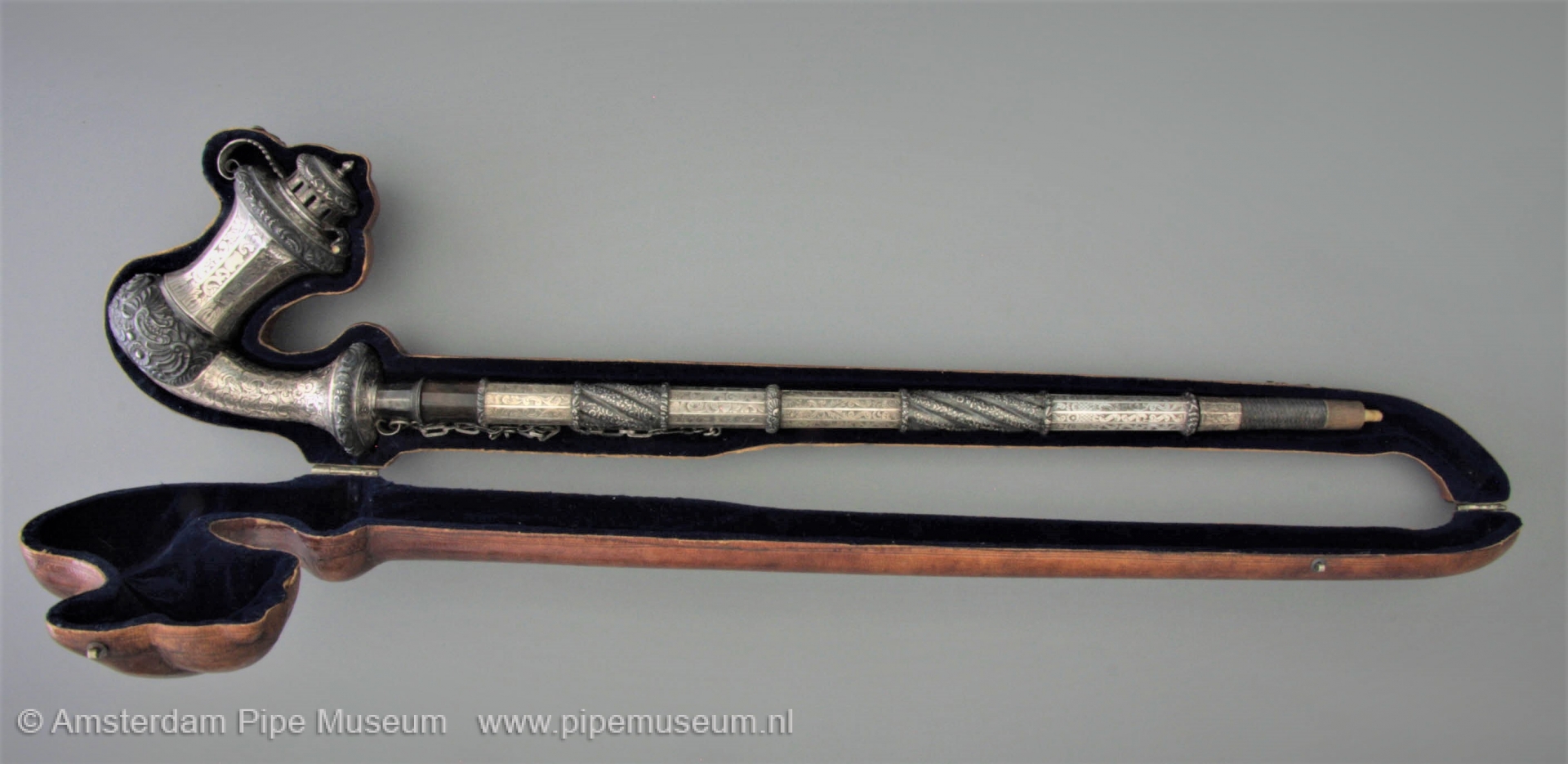
Meerschaum is the most suitable of all materials for smoking pipes. It absorbs moisture, is lightweight and therefore enjoyed great prestige. Not surprising that the nobility liked to smoke from a meerschaum pipe. Nevertheless, for some smokers the appearance was insufficiently prominent. We think of the most spoilt smokers. The breaking in of meerschaum was a long way during which the appearance of the pipe changed by the colouring process; that did not always look fine. By packing the pipe in a metal jacket, the appearance could be better controlled. With this tobacco pipe, this has been achieved successfully so that the appearance is more elegant than with any other pipe.
A meerschaum pipe bowl with a Turkish shaped bowl was taken as a starting point. Not a simple shape turned on a lathe, but a twelve-sided bowl with a funnel-shaped model and the characteristic bulging spherical base. Given the shape we can assume that it was a better piece of meerschaum, otherwise all the trouble to flatten the bowl into facets would not have been worthwhile. Characteristic is also the rounded rat tail along the bottom of the pipe bowl. It is therefore a pipe shape that is characteristic of Turkey, but that was copied in Hungary and Austria in large numbers, later even in Germany.

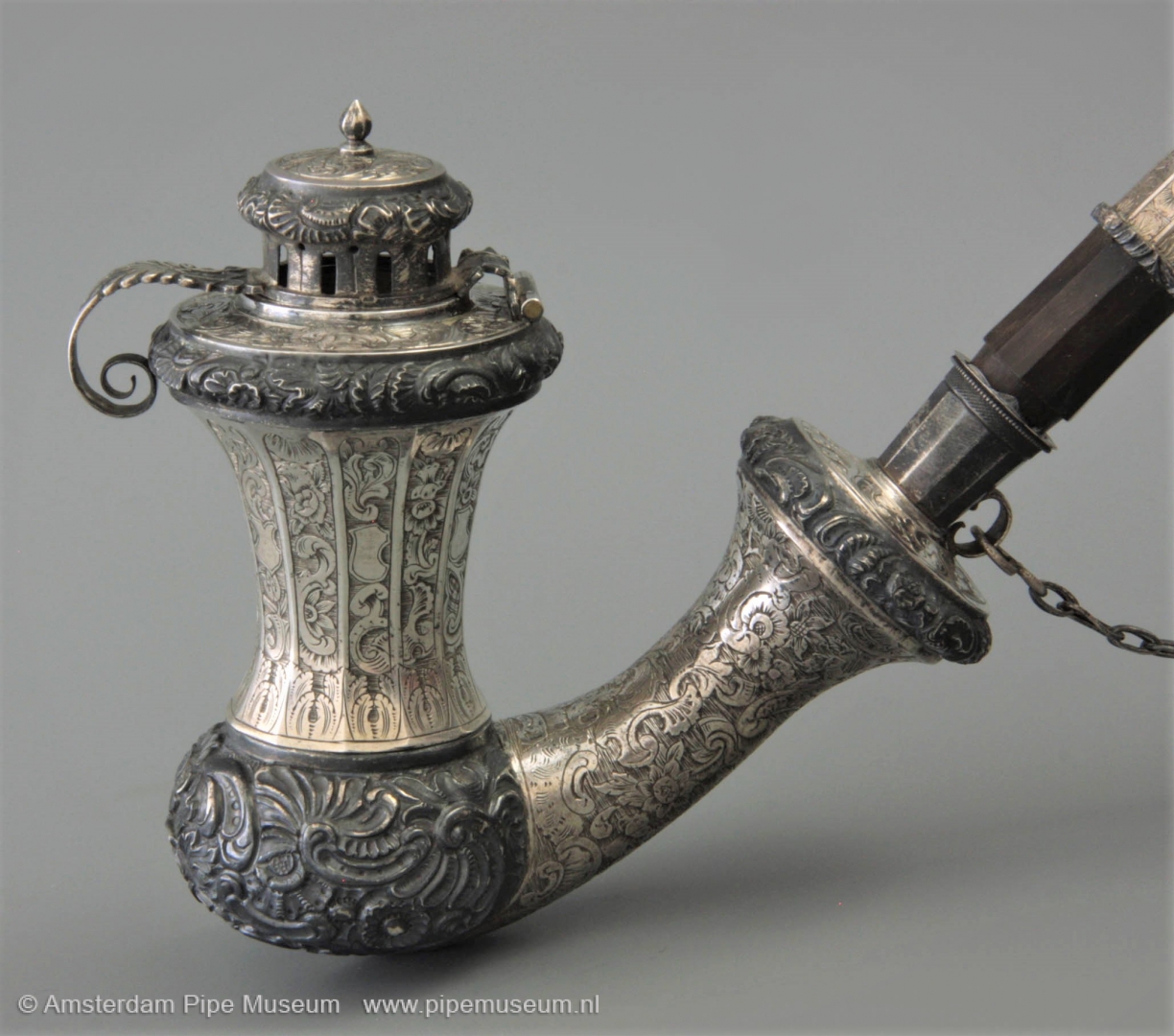
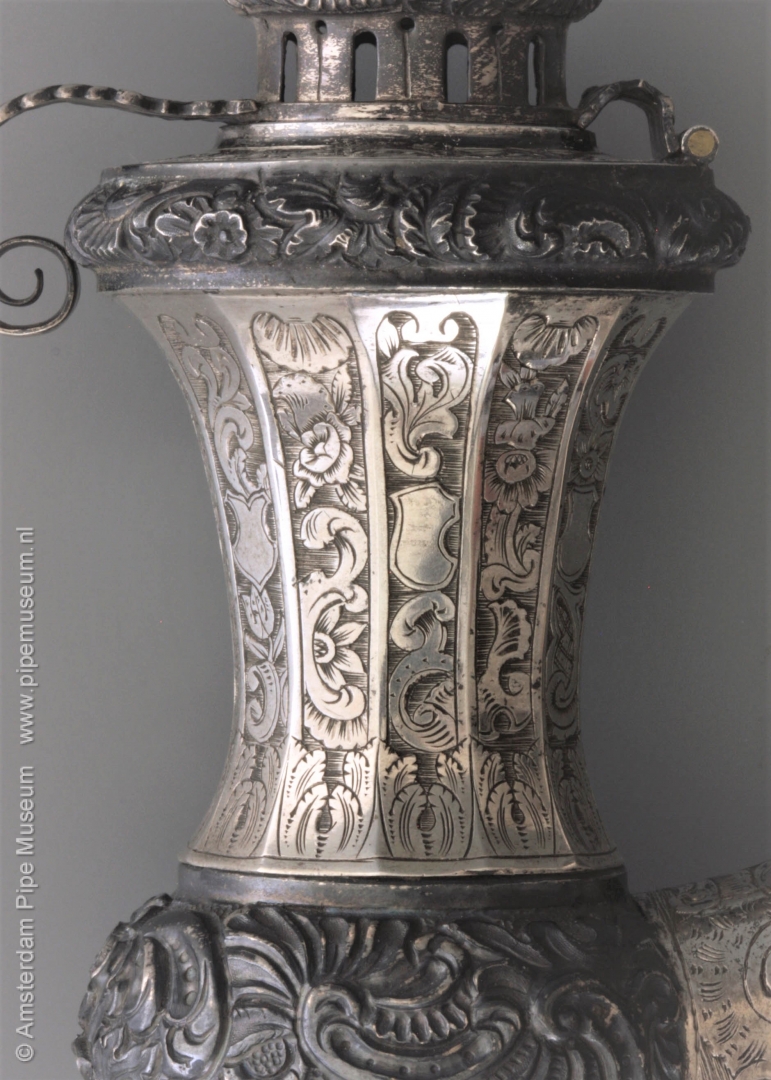
Afterwards this bowl was completely mounted in silver. Not just in a simple die-cut cover that was pressed into two or three pieces and then soldered together, with a much more luxurious design. Sheets of silver in two different alloys with respectively embossed and engraved decorations were soldered together until an attractive rhythm emerged. Fitting in this lining, the silver hinged cover is shaped like a drum, pierced with standing slot-shaped air holes. A fine pinnacle adorns the top. And note the beautifully worked clamping spring with double curve. The motives, purely ornamental, are completely executed in neo-rococo style. This style is characterized by asymmetrical details in a symmetrical structure in which cartouches and foliage dominate. The decorations are extremely pure and perfectly detailed which makes us assume that the silversmith consulted a modelling book for the ultimate result.
The pipe is completely preserved with its original stem, long, straight and also multi-sided, consisting of sections buffalo horn. Fully matching in style, this stem is also lined with silver, in alternating engraved and embossed zones. At the end of the stem is the so-called slab or flexible part wrapped in silver wire, ending in a horn mouthpiece. That flexible part gave the smoker the comfort of a stem that follows each movement. To ensure the connection between bowl and stem, a double silver chain with elongated links runs from the stem to the bowl. This precious pipe is protected by a wooden casing, which is shaped tightly around the object, closed by two brass hooks. The outside is covered with brown leather. Dark blue velvet is applied internally. The total length of the case measures no less than 49 centimetres.
All in all, due to its garnishing this pipe got an exceptional appearance. The labour-intensive lining in two silver alloys in two changing techniques gives the pipe a luxurious appearance, if not ostentatious. In any case, at the time it was a very valuable and, above all, unusual piece. The special case shows the same high degree of luxury. Yet it has not become the owner's favourite. However prestigious, the pipe has never been smoked. Considering its pedigree, the date must be between 1835 and 1845.
Amsterdam Pipe Museum APM 19.535
Mandarin of coquilla nut
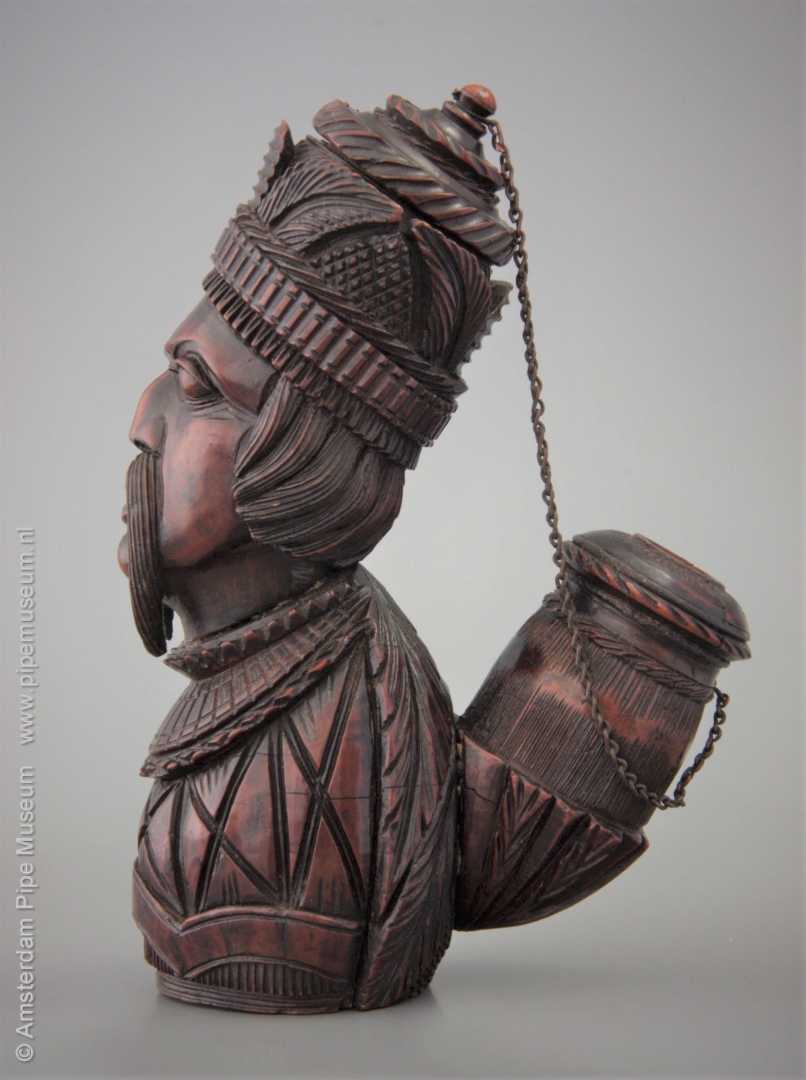
This tobacco pipe made from coquilla nut really is a magnificent piece of craftsmanship. The bowl represents the bust of a Chinese mandarin with a hanging mustache. On his head he wears a cylindrical cap with geometric decoration of bands and shields with feathers. The bust, which also serves as the base of the pipe, is geometrically decorated with crosses and large feathers on the back, all enclosed by a richly pleated collar. The stem is oval-shaped with various geometric bands and rings. The pipe bowl is covered with a disc-shaped lid that is attached to the stub with a retaining chain. All in all, it is a fantastic but also somewhat artificial design.
Coquilla nut is an exquisite material that has been popular for several centuries for fine carving and especially turning work because of its hardness and consistent mass. In fact, it is the fruit of a certain type of coconut tree found in Central and South America. Its official name is Attalea funifera. Dried it has a beautiful brown shade with a high shine. In the nineteenth century in particular, a real industry of small objects made from these nuts arose. The objects are shaped using simple lathes, often with some additional hand carving.
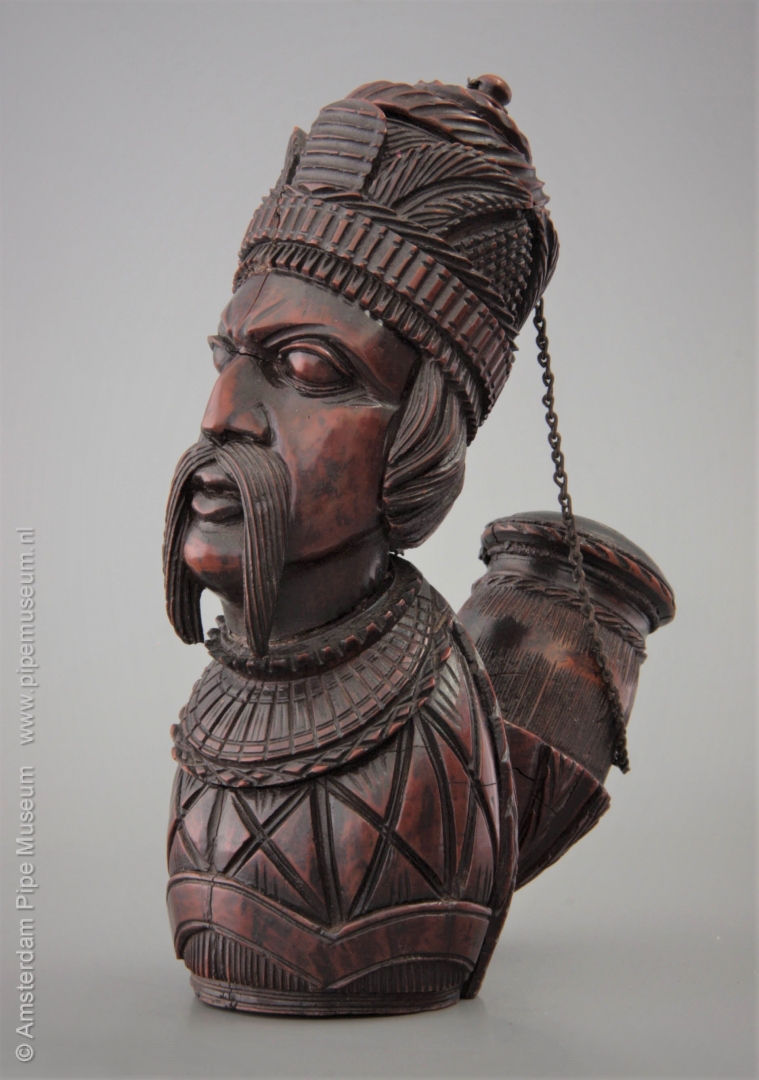


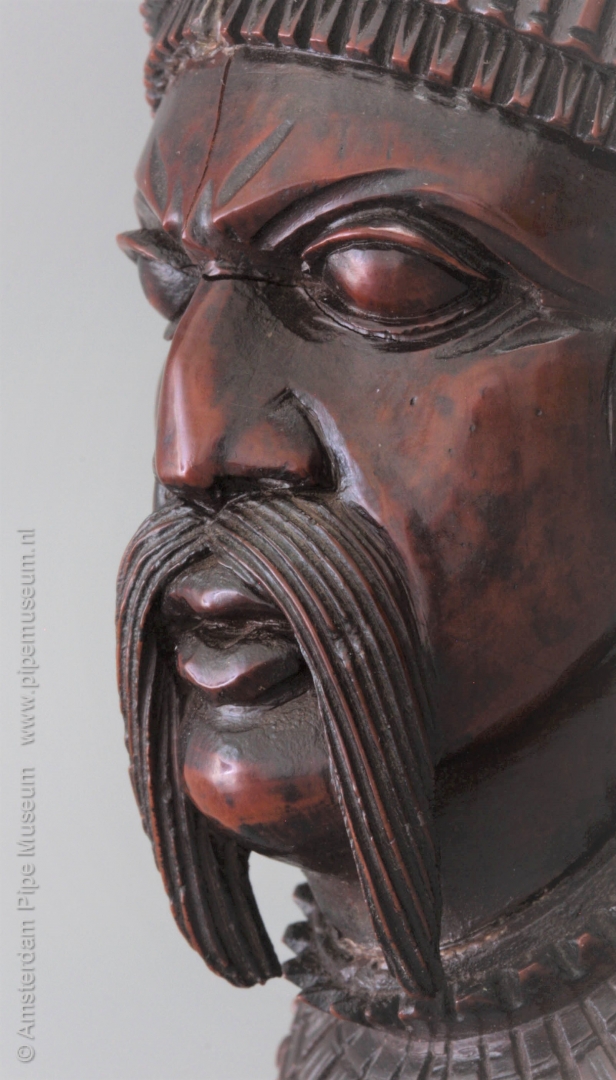
You can clearly see that our tobacco pipe is formed by connecting three different nuts. The bowl is the first and largest nut, the base is a second with the tip cut of to have a standing surface, the stem is the third and smallest nut. In order to actually use the object as a smoking pipe, the nut must be protected against burning-in; after all, it remains an organic material. To this end, the pipe bowl is internally provided with an inner bowl, usually with meerschaum paste as here. Sometimes the bowl of a clay pipe is used as an interior for the pipe. In addition to protection against burning, this inner bowl guarantees the neutral taste of the tobacco pipe. However, these deployments do appear to be quite vulnerable in use.
The coquilla nut has long been used to make finely turned rosary beads. In addition, pocket boxes and flasks occur, even occasionally a pipe case. Extremely popular items are the ornamental eggs designed to hold small trinkets. If you drill open such a box with many holes, it can be used as a flea trap, especially popular in England. A boom in snuff boxes arose in the mid-nineteenth century. As it turns out, the nut is very suitable for keeping the snuff fresh due to its somewhat greasy material. As soon as this characteristic was discovered, it was used.
Over time, the popularity of these exotic nuts diminishes. The carving turns out to be fragile, especially the highly decorated objects quickly lost their value when parts break off. Other raw materials take the place of the coquilla nut. Thus, this once-important production crumbles, while damaged items are thrown away. However, our mandarin was spared that fate. Apparently this object had found a careful owner who only smoked the pipe a few times.
Amsterdam Pipe Museum APM 16.212
Commemorative pipe for the Vienna Congress
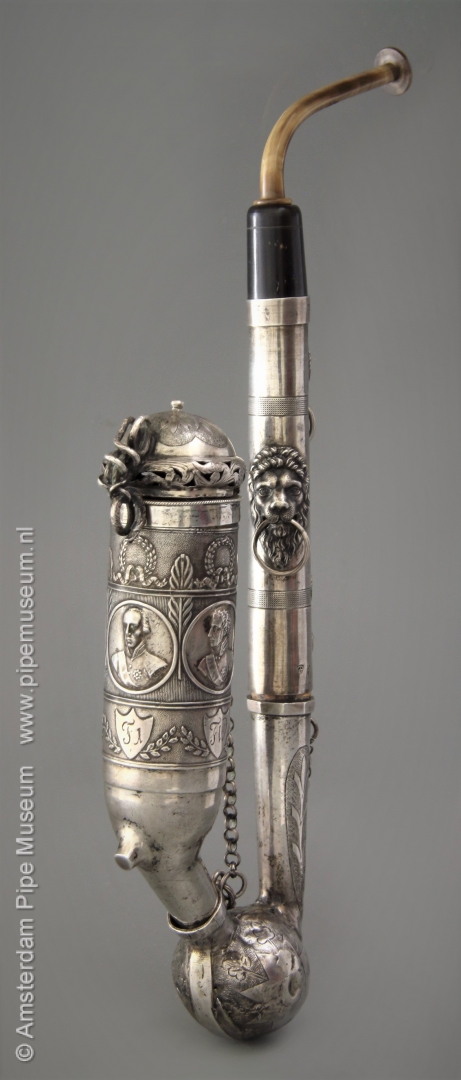
This completely silver tobacco pipe is a luxury souvenir of an historic event more than two hundred years ago. Not the chic material but the images on the pipe makes this object historically interesting. The inner bowl is probably made of ceramic, covered with die-cut silver plate on the outside. Around the tall cylindrical pipe bowl we see classical motifs dominated by three circular portrait medallions. These show the busts of three monarchs with underneath them from left to right coats of arms with the abbreviations "A", "F1" and "FW". Around the top are empire motifs with palmettes and three laurel wreaths, the lower half of the bowl is undecorated. The pipe bowl is mounted with a domed silver hinged lid with a knob in the center, the overhanging rim has cut-out air inlets. A complicated winding snake acts as a clamping spring.
The pipe has been preserved with its original mounting consisting of a spherical moist trap with an upright stem widening in a narrow sleeve also in silver. It has a straight stem, again covered with silver and provided with three relief lion masks with a ring in the beak. The top is made of buffalo horns with a mouthpiece with button. The usual retaining chains run from the bowl opening to the moist reservoir and from the stem to the reservoir.
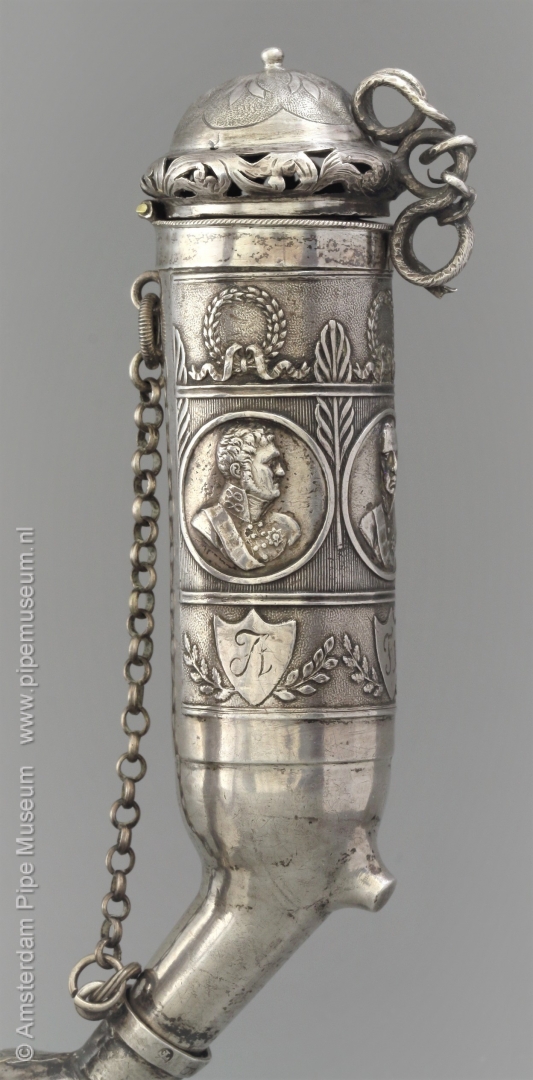

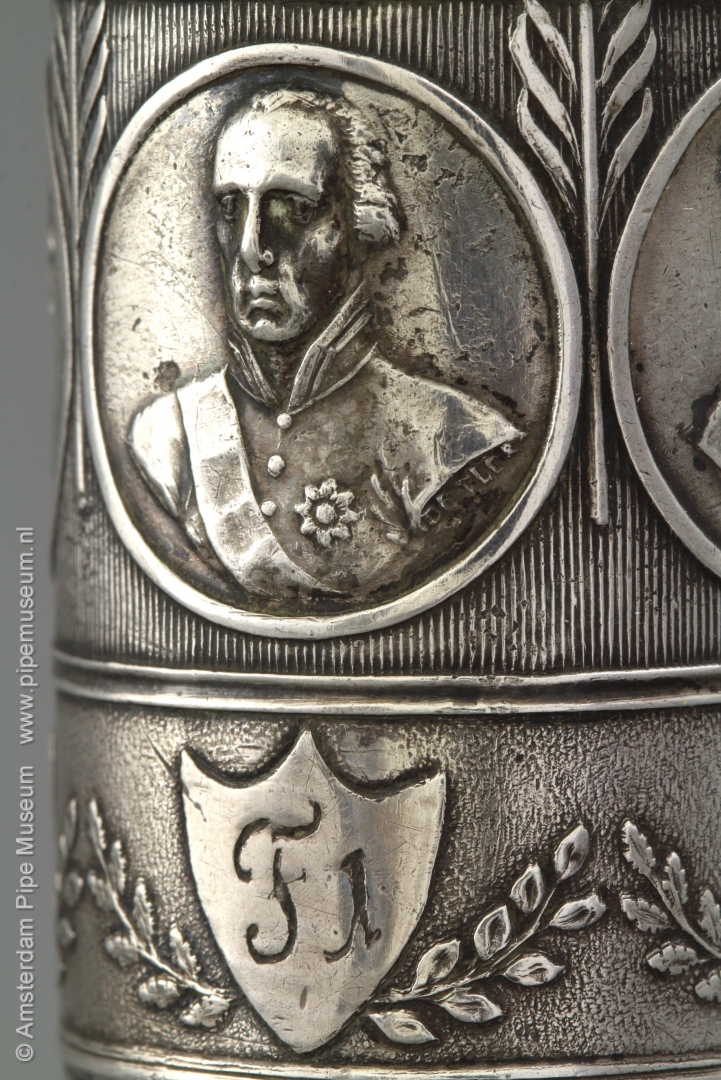
This special pipe is an commemorative piece made on the occasion of the Vienna Congress. Before the official opening of the Congress on November 1, Emperor Francis I of Austria greeted the Russian Tsar Alexander I and King Friederich Wilhelm III of Prussia on September 25, 1814 for a joint festive entry into Vienna. A scene watched by many tens of thousands of people. None of these monarchs was personally present at the signing of the final act nine months later. Only the first days of the congress they were in Vienna for both the opening and the countless festivities such as balls and fireworks in the Prater.
Interestingly, the medallions were made by a medalist of renown and fame. Franz Detler (1785-after 1835), who worked in Vienna, signed the product on the sleeve cut with his name. Detler, known for countless prestigious medals, was a medalist and stamp cutter by trade. Whether this pipe was made in his workshop or whether he only cut the die is unknown.
Thanks to the silver marks, we can prove that the pipe must have been made in the 1810s, at the earliest 1814 and no later than 1819. The control mark indicates that it was in the city of Vienna. This makes the silver pipe an historical souvenir of an important diplomatic congress that defines the essence of Europe to this day. How many conference attendees went home with such a tobacco pipe is a guess. It is certain that it was a serial item, albeit of great luxury. In that context it is interesting to know that there is another simple variant made with the same molds.
Amsterdam Pipe Museum APM 23.225
A tooth as a pipe bowl
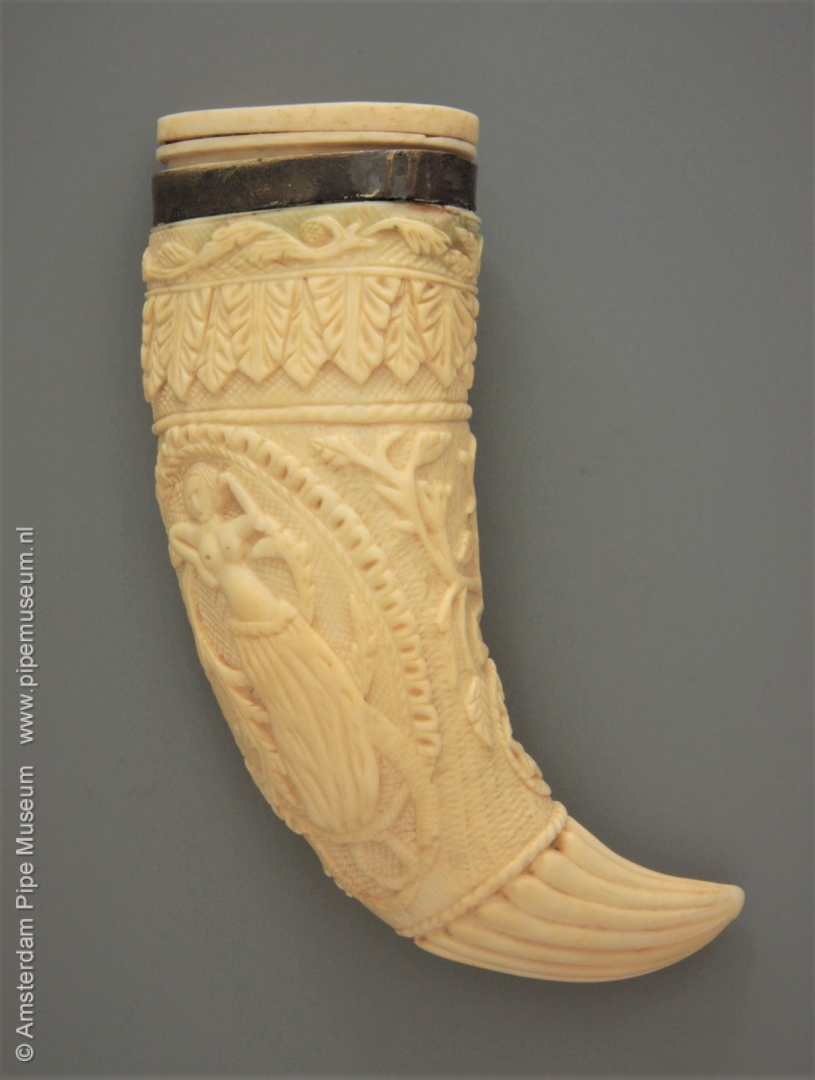
Many pipes that we classify in the category other materials are made as souvenirs or as special pieces of craftsmanship. It is not about serial products, but about individual pieces with a high level of oddity and often a lower value of use. That is also the case with this pipe bowl made from a sperm whale tooth. Much carving in tooth and bone was made abroad by Western European sailors. They had the time when the ships were waiting for a favourable wind for weeks. In other cases the exotic material was taken to the home country giving birth to a small-scale industry, often in the port cities. We can no longer determine whether we are looking at foreign products or local home-made goods; the work of the patient dilettante remains the same.
In any case, the pipe bowl depicted here is carved from a sperm whale tooth, even retaining its shape. By simply scraping out the hollow part of the tooth and sawing off the root part, the pipe bowl was created. Then it is provided with a relief decoration that runs completely around the bowl. Slightly to the left of the front we see a dancing woman with bare torso in a standing oval. On the right side a standing man with pipe is surrounded by branches with leaves. Both depictions closely connected with the life of a sailor man. Along the top edge the maker has carved a sloping tendril with leaves that end in the shape of animal heads. As a filling, a ring with acanthus leaves was appropriate. The bottom of the pipe bowl, in fact the tip of the tooth, is decorated with fluted lobes.

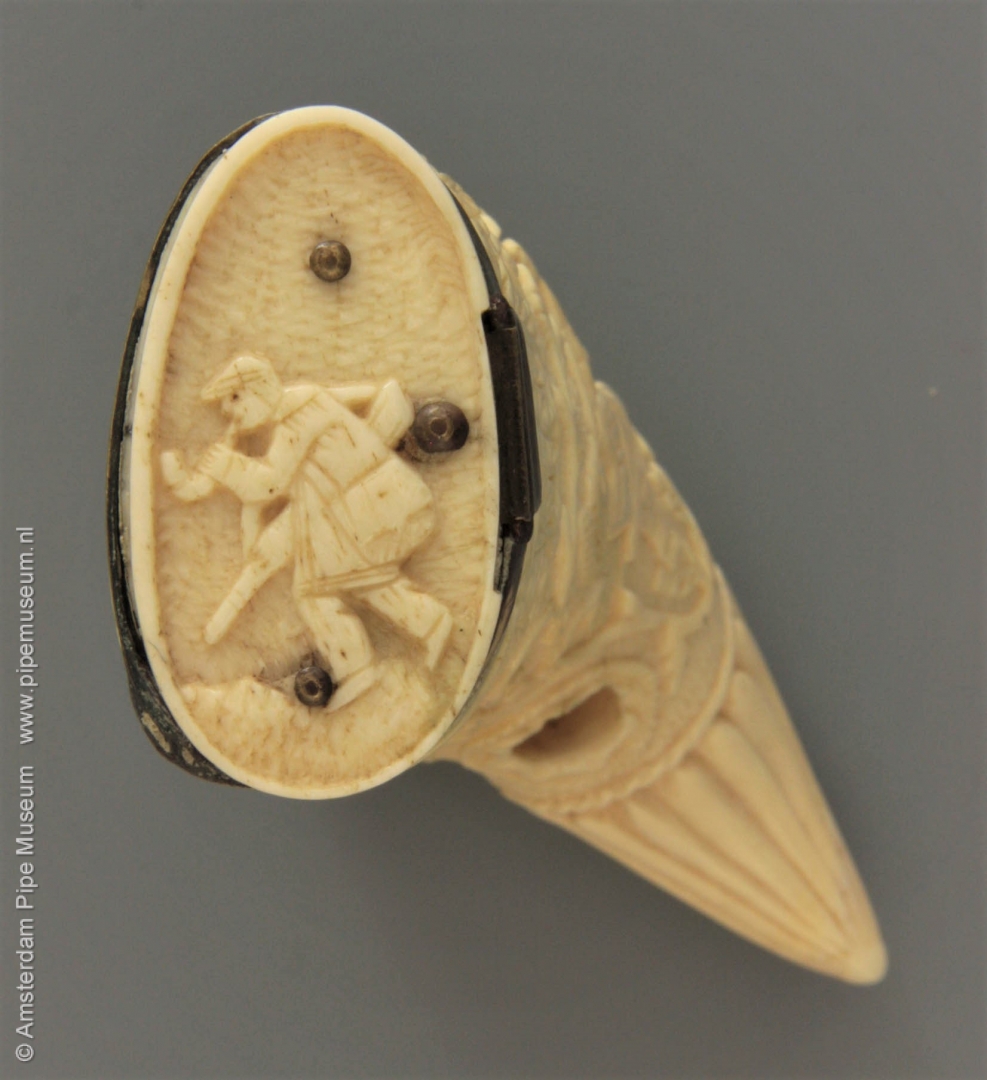
For the stem, a hole was drilled halfway the pipe, at the base of the inner bowl. A stem of wood, bone or other material could be inserted. The bowl opening is mounted with a flat hinged cover also made of tooth material. This part is carved as well, very appropriately with a standing smoker with gun on a broad shoulder strap. Strangely enough, the maker forgot to provide the lid with air holes, so that the pipe could only be smoked with the lid open. Incidentally, that never happened and that confirms the ornamental function of the object.
Whoever made this pipe bowl will never be known, but given the motives a maker of German origin is most likely. It is possible that the pipe originated in northern Germany, where fishing boats could easily catch a sperm-whale in the northern waters, either shot or otherwise by exchange. The choice of the subject in the carving is more a reference to manufacturing during a trip than to domestic art at home. The period of creation is also rather unclear. That may be at the end of the eighteenth century but may also have occurred in the first half of the nineteenth century.
For years, this pipe bowl was the mascot for the Seita museum in Paris. As a bookmark or postcard this object has become known worldwide. Furthermore, it is also depicted in half a dozen books. In 2009 the collection of this French museum came under the hammer and this object was acquired by the Amsterdam Pipe Museum. This is where the object functions as one of the bizarre examples of pipes made of special materials.
Amsterdam Pipe Museum APM 19.891
Deer antler hunting pipe
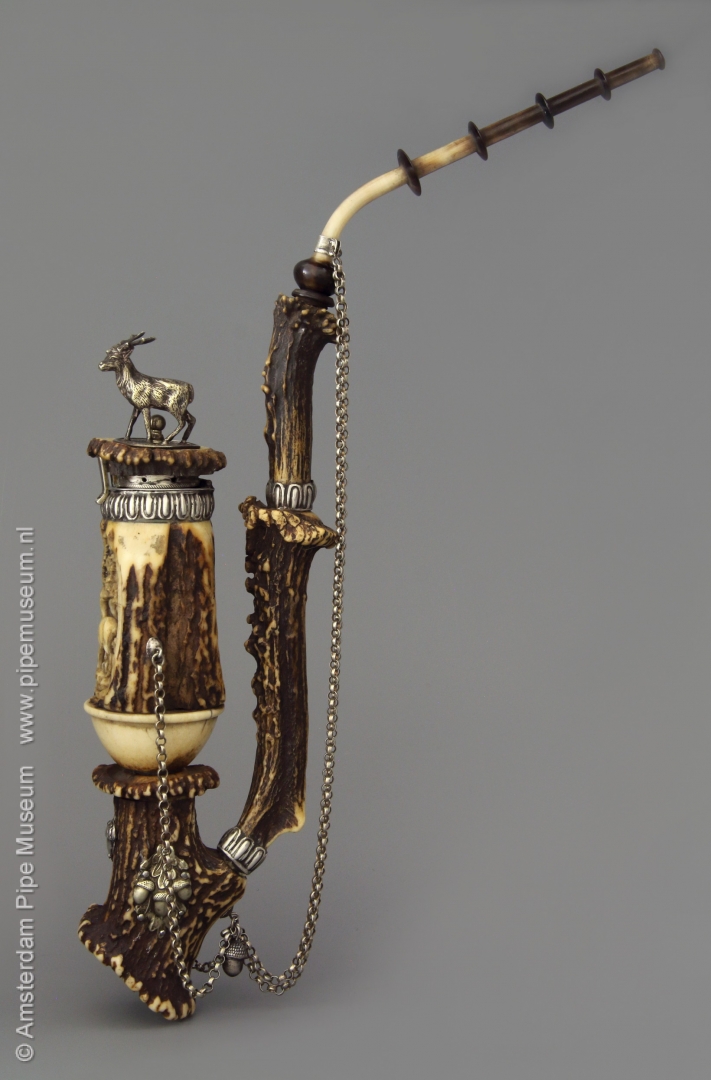
In the German states, where the phenomenon of hunting is extremely popular, it is not surprising that hunting scenes are depicted in smoking pipes. In fact, often such pipes show in everything the glorification of hunting as sport and livelihood. Nothing is more suitable than using materials from hunting trophies. One such wondrous material is stag or deer antlers processed into pipes. A whole industry grew out of this activity in the town of Meiningen in Thuringia. That started already in the early nineteenth century.
The standard stag antler pipe is a mounted, upright pipe bowl attached to a curved stem with bent horn mouthpiece. In terms of silhouette it resembles the usual German pipe. In this case, however, we discuss a Gesteckpfeife that is made out of stag antler. Characteristic of a Gesteck pipe is that several parts are screwed together and that the pipe bowl is placed on a base that also serves as a moisture reservoir. The pipe is more artificial and it shows a slightly different silhouette that is unique in its kind.
The pipe in question is made of five pieces of deer antler put together in an unexpected way. Most striking is the cylindrical pipe bowl, made out of the thickest piece of antler. This pipe bowl has carvings on the front. In a standing oval a deer and a hind are depicted in front of a tree in the background. That pipe bowl base is milled in a round shape and is white as a result. This pipe bowl is placed on a separate base, which is more or less copied from the moisture reservoir of the Gesteck pipe, however using the shape of the natural crown of the antlers. The flat base is decorated with another standing deer in carving. The stem, consisting of two small antlers, rises from this base. A long buffalo horn mouthpiece finishes the pipe. All in all it is an astounding contraption.
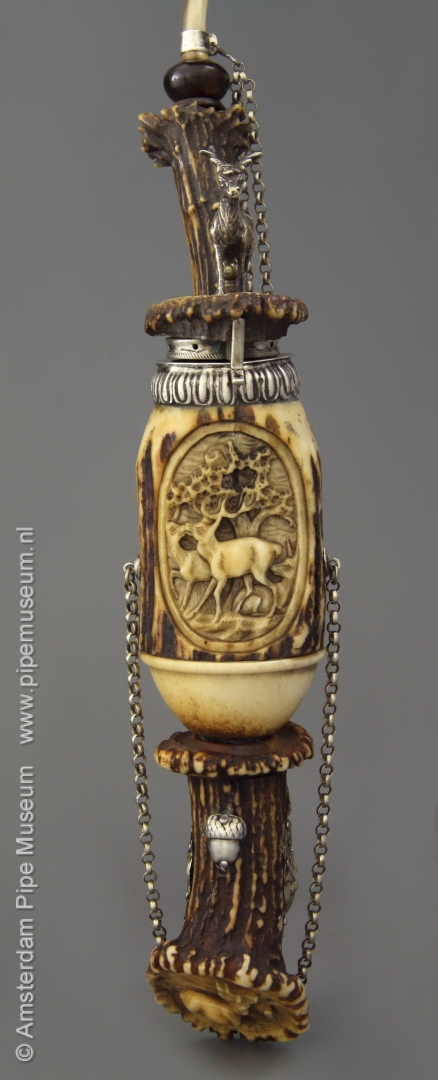
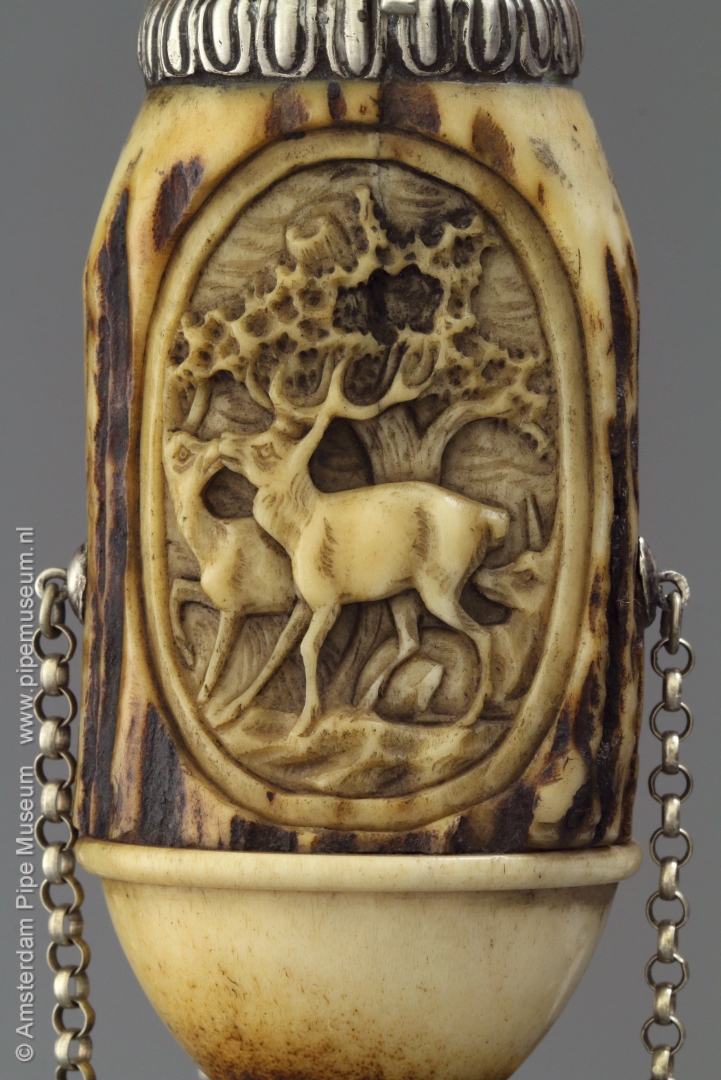
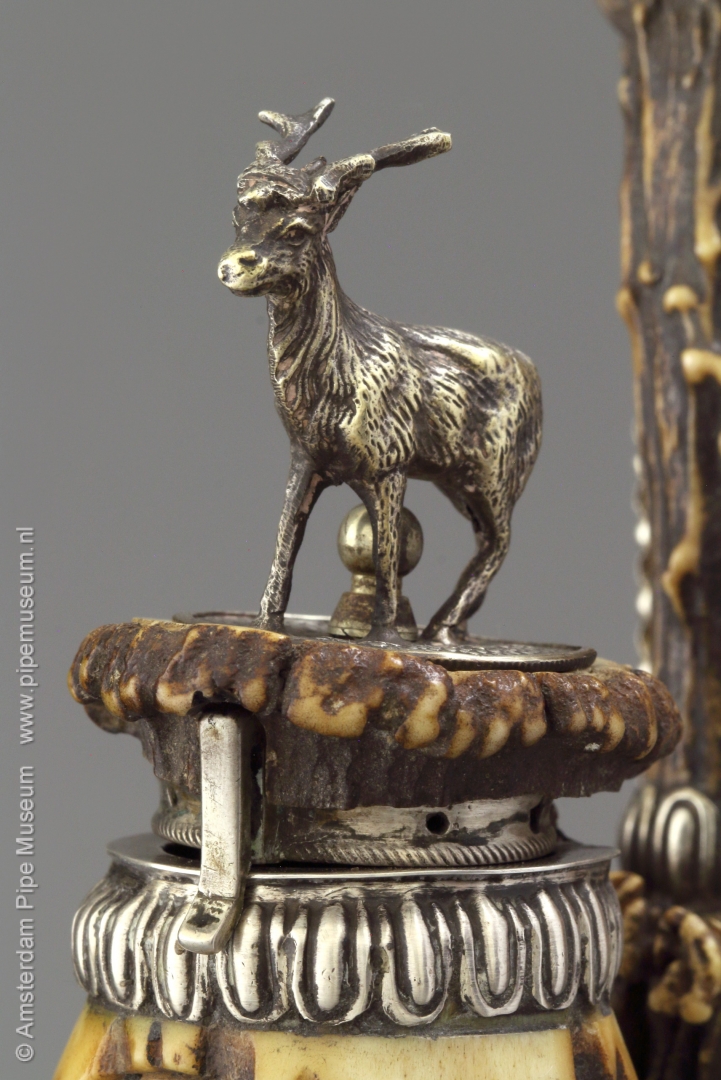
The maker has clearly played with the colours of the material. For that reason, pieces of the brownish bark-like antler have been cut away, revealing the ivory undercoat. We see this in the oval, but also in the base of the pipe bowl and on the stem. That colour contrast contributes to the pipe's appearance. This is reinforced with silver ferrules that mark and connect the parts in places.
The elegant finishing touch is the lid, which consists of disk in deer antler mounted with a silver miniature standing stag. The pipe maker ordered these figures from a foundry that had a selection in stock for such demands. On a pipe like this they are a welcome addition. For practical use, silver safety chains were a necessity. They often occur in German pipes and make the appearance more luxurious. The point where three chains come together is complemented with a silver acorn.
Although it is a contrived structure, we must admit that it is in the end a beautiful product. Attractive by its interesting contrast of the rough stag antler with the smoothed parts, also an interplay between the whimsical shape of the material and the artificial carving, both contrasts are enhanced by the silver accents, which also include the three appliques with acorns on the base. Even the hues of the buffalo horn stem match the colour palette of this pipe in completing the object. Still, a Dutchman has to get used to such a queer, somewhat bombastic object.
Amsterdam Pipe Museum APM 24.356
Silver pipe with coiled stem

Metal is not the most suitable material for making a smoking pipe. It does not absorb moisture and it heats up too quickly. It will produce a moisty, too hot and by consequence not very tasty smoke. On the other hand, a pipe made of silver is always a status object. The price of the raw material and the exclusive appearance means that it is not for everyone to own something like it. That certainly applies to this tobacco pipe, that has something comical because of the portrait head in the bowl and the sitting poodle on top of a hoop.
The bowl is shaped like the head of a man with a large mustache and a cylindrical cap on his hair. It is actually a somewhat naive representation of a hussar. Looking at the stem decoration, however, you would expect it to be a dog trainer or else a circus performer, who can of course dress up as a soldier type. The hat ends in a serrated brim, on which, as an extra decoration, a dome shape with leaf motifs. A few holes in it provide the air supply. The lid is secured to the top of the stem curl with a long retaining chain. Behind it we see a hoop with a poodle on it. All elements point to a dog trainer or circus performer.
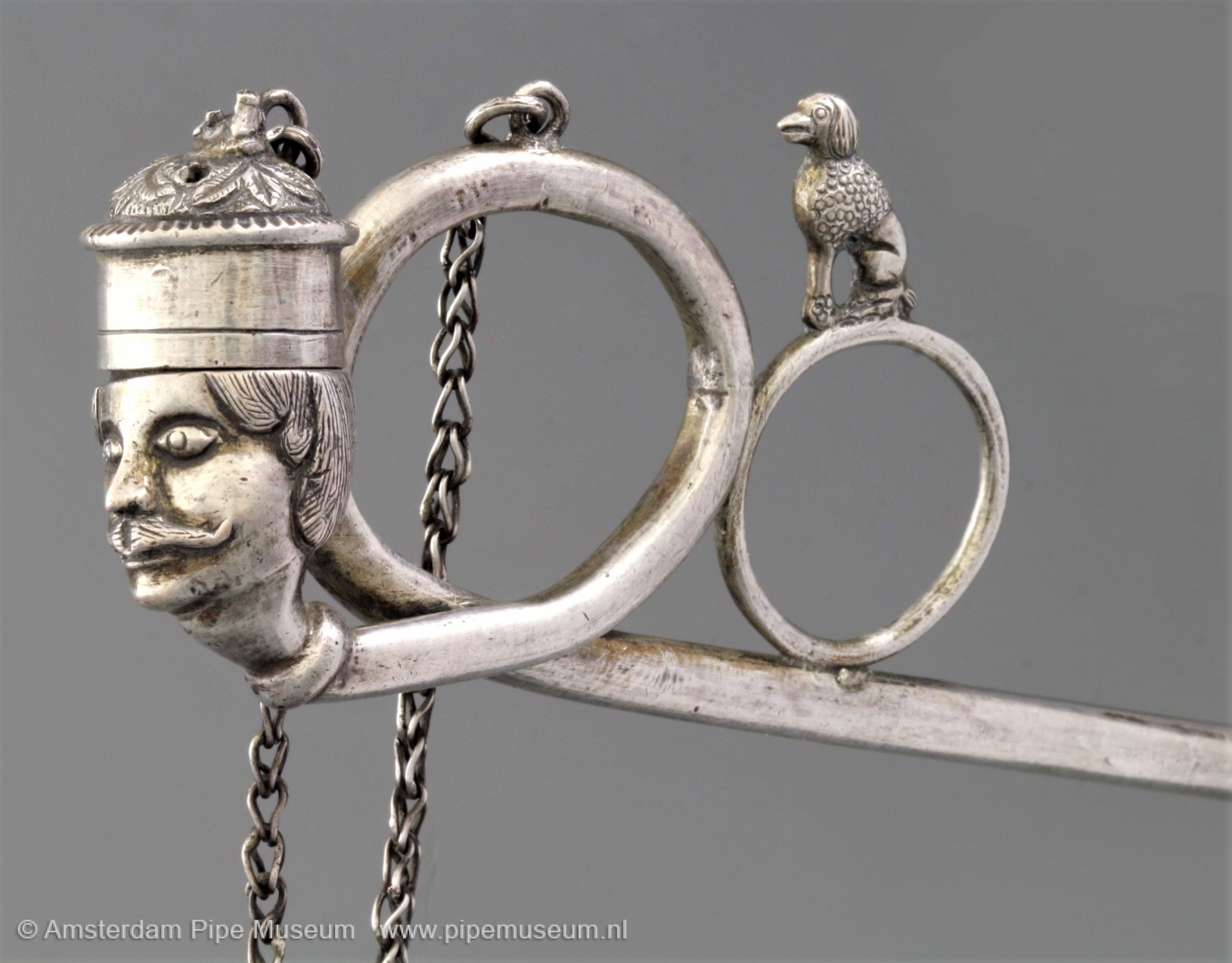
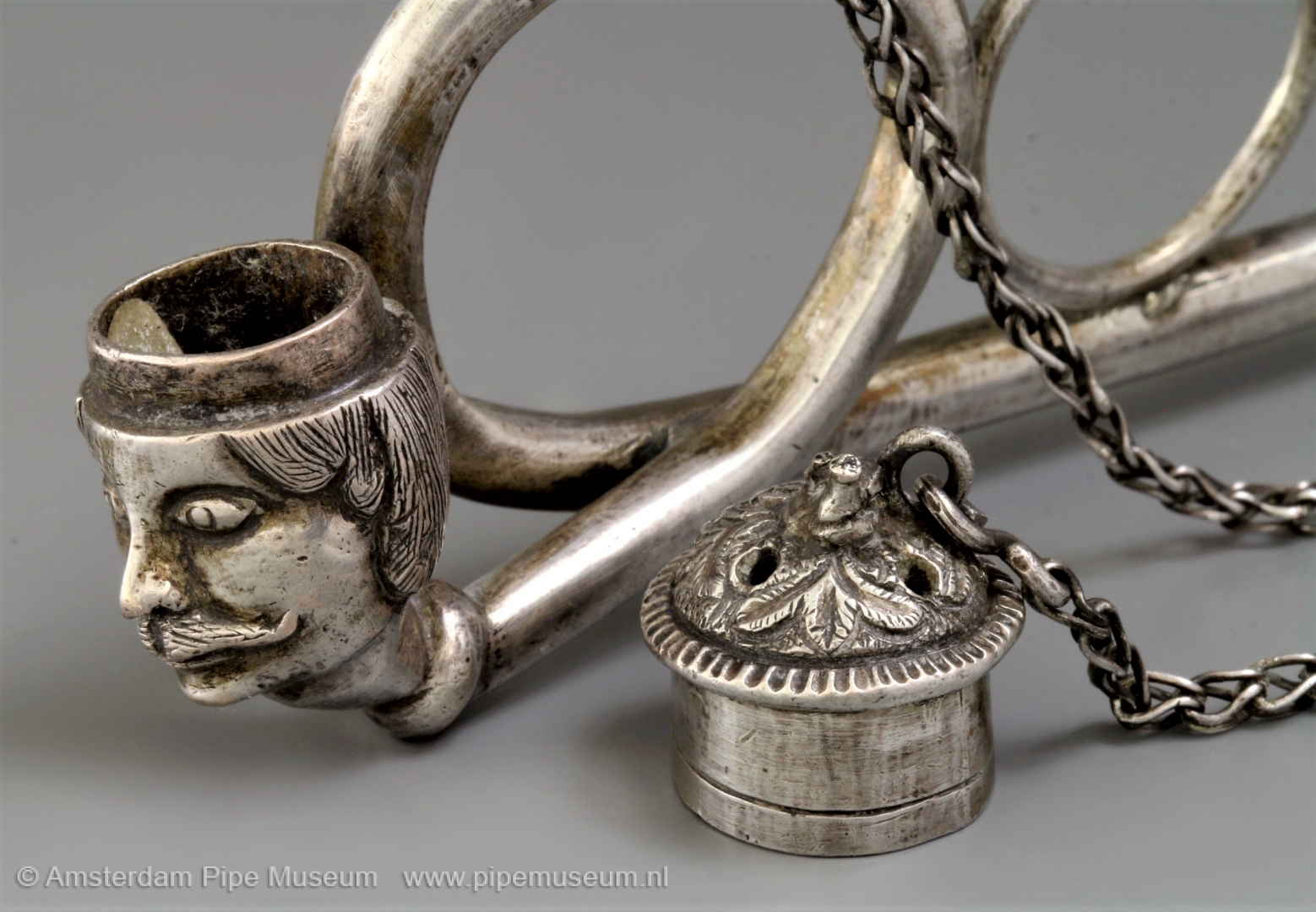
In the mid-nineteenth century the circus was extremely popular, it was all the rage in England, but circus groups from Italy, France and Germany also traveled around the continent. A well-known dog artist came from Berlin with his poodle Pollux. He is known for performing a folklore dance in 1848. Poodles were one of the most beloved circus animals anyway, because they were so easy to train in actions unusual for the dog. The shaving method is typical of the nineteenth century, with curls around the chest and a bald rear end. Dozens of images of such poodles can be found in newspapers and magazines, as well as on posters from the time. It is difficult to say whether our pipe portrays a dog from one of these famous acts. For certain, it was a very popular motif.
As noted, metal is not a fine material for tobacco pipes. Nevertheless, this pipe probably didn't even smoke that badly, due to the length of the stem. With its wide bend it goes towards thirty centimeters lenght. This gives the pipe sufficient cooling to allow the taste to be pleasant. It is still a mystery for whom such a product was made and what the user conveyed as a message. The chic material places the pipe with the better positioned, but the circus-like representation is typical popular.
Amsterdam Pipe Museum APM 23.042
Bristol or Nailsea glass

No material in the world is less suitable for making pipes than glass. It is fragile by nature, does not absorb and conducts heat poorly. When the pipe is filled and lit, the chances of fracture are extremely high. Quite unexpected, numerous pipes have been made of glass. The main production centres are in England: Nailsea, Bristol and Stourbridge, always mentioned in the same breath. It is not surprising that the names of these three places are often used as a generic name for the glass pipe. However, there is hardly any evidence for this statement.
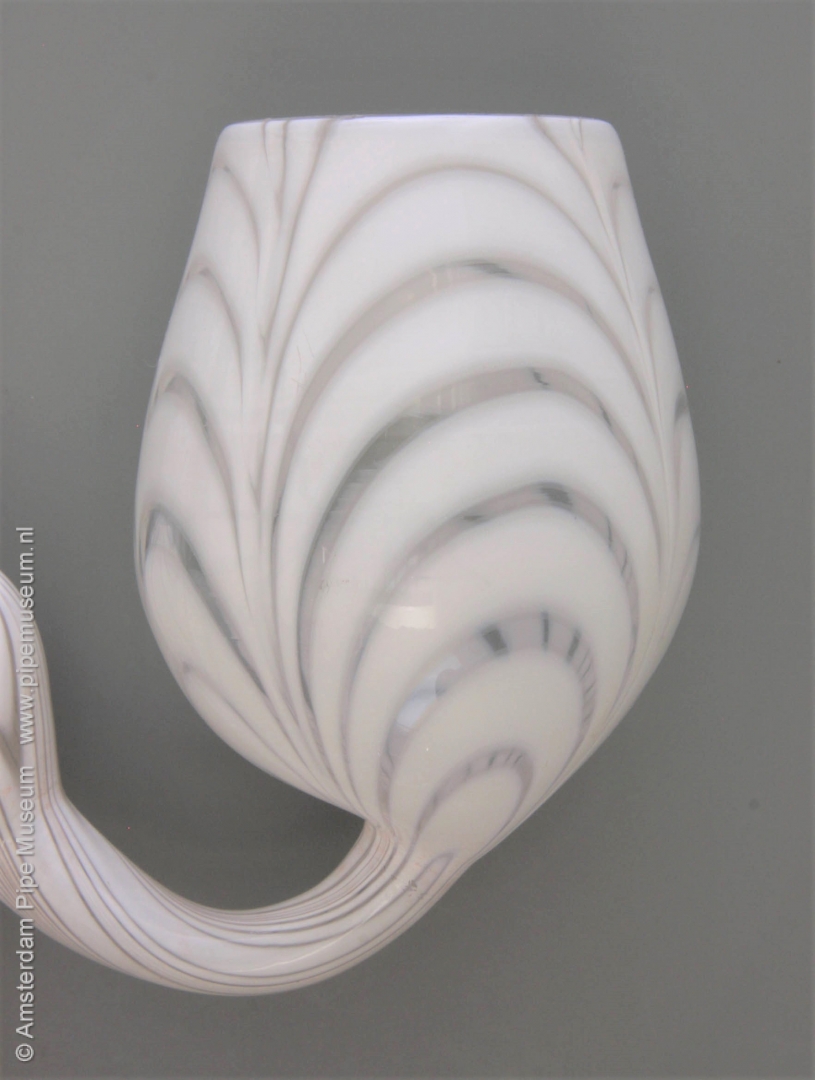
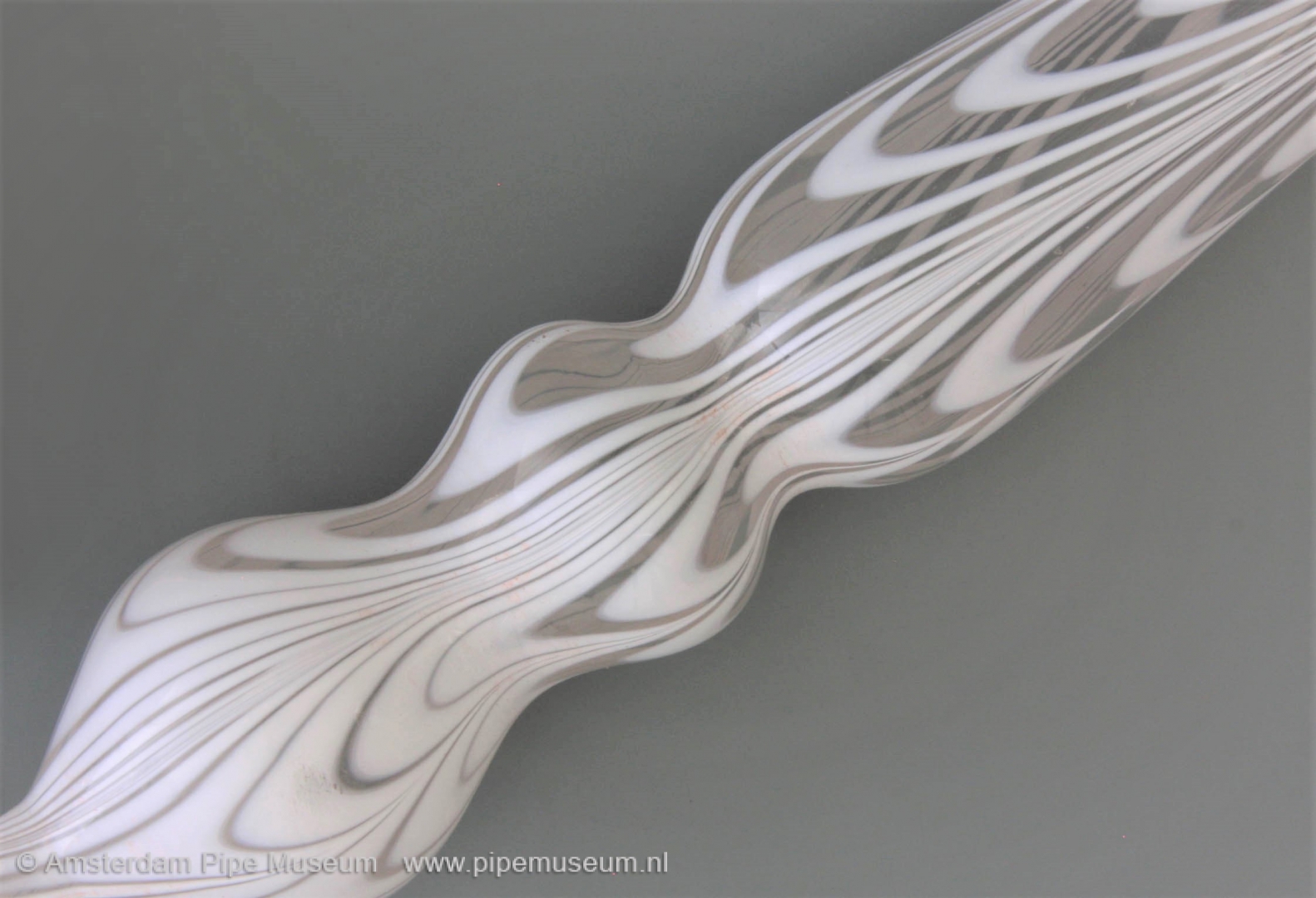
The Amsterdam Pipe Museum also owns a series of such eye-catching, but at the same time kitschy pipes. It is certain that they are never meant to be smoked, with the exception of the small versions could be used as cigar holders. The rumour that they were signs for the tobacco shop, is still unproven. More logic and therefore true, is that they have only an ornamental function. That is why they were sold at specific locations, especially as a curiosity on annual markets.
The pictured copy with giant bowl and thick slightly curved stem is 44 centimetres long. Because of the work, this can be attributed to both Nailsea and Bristol. The pipe is blown out of transparent glass and is decorated in the so-called latticino technique. A pattern of milk white stripes with a certain regularity runs like a network over the object. It is an admirable piece of glassblowing art, but with its wondrous convex shape and wide stem with two spheres and a baluster it still has a somewhat unusual shape without any practical use.
As a matter of fact, no pipe collection is complete without these remarkable glass objects. They are added to many historic collections to show the most extreme of smoking equipment, but the question remains whether it is related to smoking at all. They come into being during the nineteenth century, the oldest mentions date from before 1860. The production will continue until the year 1900. Because of their fragile material they quickly become rarer, but for the current pipe enthusiast the interest focus more likely on more serious smoking objects in other materials.
Amsterdam Pipe Museum APM 19.872